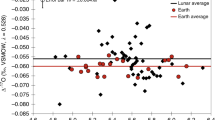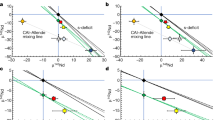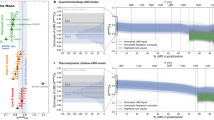Abstract
Characterization of the hafnium–tungsten systematics (182Hf decaying to 182W and emitting two electrons with a half-life of 8.9 million years) of the lunar mantle will enable better constraints on the timescale and processes involved in the currently accepted giant-impact theory for the formation and evolution of the Moon, and for testing the late-accretion hypothesis. Uniform, terrestrial-mantle-like W isotopic compositions have been reported1,2 among crystallization products of the lunar magma ocean. These observations were interpreted to reflect formation of the Moon and crystallization of the lunar magma ocean after 182Hf was no longer extant—that is, more than about 60 million years after the Solar System formed. Here we present W isotope data for three lunar samples that are more precise by a factor of ≥4 than those previously reported1,2. The new data reveal that the lunar mantle has a well-resolved 182W excess of 20.6 ± 5.1 parts per million (±2 standard deviations), relative to the modern terrestrial mantle. The offset between the mantles of the Moon and the modern Earth is best explained by assuming that the W isotopic compositions of the two bodies were identical immediately following formation of the Moon, and that they then diverged as a result of disproportional late accretion to the Earth and Moon3,4. One implication of this model is that metal from the core of the Moon-forming impactor must have efficiently stripped the Earth’s mantle of highly siderophile elements on its way to merge with the terrestrial core, requiring a substantial, but still poorly defined, level of metal–silicate equilibration.
This is a preview of subscription content, access via your institution
Access options
Subscribe to this journal
Receive 51 print issues and online access
$199.00 per year
only $3.90 per issue
Buy this article
- Purchase on Springer Link
- Instant access to full article PDF
Prices may be subject to local taxes which are calculated during checkout


Similar content being viewed by others
References
Touboul, M., Kleine, T., Bourdon, B., Palme, H. & Wieler, R. Late formation and prolonged differentiation of the Moon inferred from W isotopes in lunar metals. Nature 450, 1206–1209 (2007)
Touboul, M., Kleine, T., Bourdon, B., Palme, H. & Wieler, R. Tungsten isotopes in ferroan anorthosites: implications for the age of the Moon and the lifetime of its magma ocean. Icarus 199, 245–249 (2009)
Day, J. M. D., Pearson, D. G. & Taylor, L. A. Highly siderophile element constraints on accretion and differentiation of the Earth-Moon system. Science 315, 217–219 (2007)
Walker, R. J. Highly siderophile elements in the Earth, Moon and Mars: update and implications for planetary accretion and differentiation. Chem. Erde 69, 101–125 (2009)
Leya, I., Wieler, R. & Halliday, A. N. Cosmic-ray production of tungsten isotopes in lunar samples and meteorites and its implications for Hf–W cosmochemistry. Earth Planet. Sci. Lett. 175, 1–12 (2000)
Kleine, T., Palme, H., Mezger, K. & Halliday, A. N. Hf–W chronometry of lunar metals and the age and early differentiation of the Moon. Science 310, 1671–1674 (2005)
Touboul, M. & Walker, R. J. High precision measurement of tungsten isotopes by thermal ionization mass spectrometry. Int. J. Mass Spectrom. 309, 109–117 (2012)
Tera, F., Papanastassiou, D. A. & Wasserburg, G. J. Isotopic evidence for a terminal lunar cataclysm. Earth Planet. Sci. Lett. 22, 1–21 (1974)
Misra, K. C. & Taylor, L. A. Characteristics of metal particles in Apollo 16 rocks. Proc. Lunar Sci. Conf. 6, 615–639 (1975)
Münker, C. et al. Evolution of planetary cores and the Earth-Moon system from Nb/Ta systematics. Science 301, 84–87 (2003)
Drozd, R. J., Hohenberg, C. M., Morgan, C. J. & Ralston, C. E. Cosmic-ray exposure history at the Apollo 16 and other lunar sites: lunar surface dynamics. Geochim. Cosmochim. Acta 38, 1625–1642 (1974)
Lee, D. C., Halliday, A. N., Snyder, G. A. & Taylor, L. A. Age and origin of the Moon. Science 278, 1098–1103 (1997)
Norman, M. D., Bennett, V. C. & Ryder, G. Targeting the impactors: siderophile element signatures of lunar impact melts from Serenitatis. Earth Planet. Sci. Lett. 202, 217–228 (2002)
Kleine, T., Mezger, K., Münker, C., Palme, H. & Bischoff, A. 182Hf-182W isotope systematics of chondrites, eucrites, and Martian meteorites: chronology of core formation and mantle differentiation in Vesta and Mars. Geochim. Cosmochim. Acta 68, 2935–2946 (2004)
McCoy, T. J. et al. Group IVA irons: new constraints on the crystallization and cooling history of an asteroidal core with a complex history. Geochim. Cosmochim. Acta 75, 6821–6843 (2011)
Fischer-Gödde, M. & Becker, H. Osmium isotope and highly siderophile element constraints on ages and nature of meteoritic components in ancient lunar impact rocks. Geochim. Cosmochim. Acta 77, 135–156 (2012)
Kruijer, T. S. et al. Protracted core formation and rapid accretion of protoplanets. Science 344, 1150–1154 (2014)
Sharp, M. et al. Characterization of the dominant impactor signature for Apollo 17 impact melt rocks. Geochim. Cosmochim. Acta 131, 62–80 (2014)
König, S. et al. The Earth’s tungsten budget during mantle melting and crust formation. Geochim. Cosmochim. Acta 75, 2119–2136 (2011)
Righter, K. & Shearer, C. K. Magmatic fractionation of Hf and W: constraints on the timing of core formation and differentiation in the Moon and Mars. Geochim. Cosmochim. Acta 67, 2497–2507 (2003)
McLeod, C. L., Brandon, A. D. & Armytage, R. M. G. Constraints on the formation age and evolution of the Moon from 142Nd-143Nd systematics of Apollo 12 basalts. Earth Planet. Sci. Lett. 396, 179–189 (2014)
Dauphas, N., Burkhardt, C., Warren, P. H. & Teng, F.-Z. Geochemical arguments for an Earth-like Moon-forming impactor. Phil. Trans. R. Soc. A 372, 20130244 (2014)
Herwartz, D., Pack, A., Friedrichs, B. & Bischoff, A. Identification of the giant impactor Theia in lunar rocks. Science 344, 1146–1150 (2014)
Ćuk, M. & Stewart, S. T. Making the Moon from a fast-spinning Earth: a giant impact followed by resonant despinning. Science 338, 1047–1052 (2012)
Canup, R. M. Forming a Moon with an Earth-like composition via a giant impact. Science 338, 1052–1055 (2012)
Halliday, A. N. Mixing, volatile loss and compositional change during impact-driven accretion of the Earth. Nature 427, 505–509 (2004)
Halliday, A. N. A young Moon-forming giant impact at 70–110 million years accompanied by late-stage mixing, core formation and degassing of the Earth. Phil. Trans. R. Soc. A 366, 4163–4181 (2008)
Chou, C.-L. Fractionation of siderophile elements in the Earth’s upper mantle. Proc. Lunar Planet. Sci. Conf. 9, 219–230 (1978)
Bottke, W. F., Walker, R. J., Day, J. M. D., Nesvorny, D. & Elkins-Tanton, L. Stochastic late accretion to Earth, the Moon, and Mars. Science 330, 1527–1530 (2010)
Stevenson, D. J. in Origin of the Earth (eds Newsom, H. E. & Drake, J. H. ) 231–249 (Oxford Univ. Press, 1990)
Deguen, R., Landeau, M. & Olson, P. Turbulent metal–silicate mixing, fragmentation, and equilibration in magma oceans. Earth Planet. Sci. Lett. 391, 274–287 (2014)
Yokoyama, T., Walker, D. & Walker, R. J. Low osmium solubility in silicate at high pressures and temperatures. Earth Planet. Sci. Lett. 279, 165–173 (2009)
Horan, M. F., Walker, R. J., Morgan, J. W., Grossman, J. N. & Rubin, A. E. Highly siderophile elements in chondrites. Chem. Geol. 196, 27–42 (2003)
Cohen, A. S. & Waters, F. G. Separation of osmium from geological materials by solvent extraction for analysis by thermal ionisation mass spectrometry. Anal. Chim. Acta 332, 269–275 (1996)
Birck, J. L., Roy-Barman, M. & Capman, F. Re-Os isotopic measurements at the femtomole level in natural samples. Geostand. Newsl. 21, 19–27 (1997)
Creaser, R. A., Papanastassiou, D. A. & Wasserburg, G. J. Negative thermal ion spectrometry of osmium, rhenium, and iridium. Geochim. Cosmochim. Acta 55, 397–401 (1991)
Puchtel, I. S., Walker, R. J., Touboul, M., Nisbet, E. G. & Byerly, G. R. Insights into early Earth from the Pt-Re-Os isotope and highly siderophile element abundance systematics of Barberton komatiites. Geochim. Cosmochim. Acta 125, 394–413 (2014)
Arevalo, R. & McDonough, W. F. Tungsten geochemistry and implications for understanding the Earth’s interior. Earth Planet. Sci. Lett. 272, 656–665 (2008)
Acknowledgements
This work was supported by NASA Cosmochemistry grant NNX13AF83G. We thank the Lunar Sample Laboratory Facility at Johnson Space Center for the provision of appropriate samples for this study.
Author information
Authors and Affiliations
Contributions
M.T. conducted the W isotopic measurements and was involved in both the interpretations and the writing of the manuscript. I.S.P. conducted the measurements of the highly siderophile elements and Os isotopes, and was involved in both the interpretations and the writing of the manuscript. R.J.W. was involved in both the interpretations and the writing of the manuscript.
Corresponding authors
Ethics declarations
Competing interests
The authors declare no competing financial interests.
Additional information
The data presented here can be found in the EarthChem library (http://www.earthchem.org/library/browse/view?id=849).
Extended data figures and tables
Extended Data Figure 1 Plot of μ182W versus source 180Hf/184W ratio.
182W values shown as open symbols are weighted averages of the data obtained in ref. 1 for low-Ti (triangle down) and high-Ti (triangle up) mare basalts; error bars, 2 s.e. of the samples of each group. The red symbol corresponds to the average of our new high-precision data for metals separated from 68115 and 68815 impact melts; error bars, 2 s.d. of the data. Based on mineral–melt partition coefficients for minerals in a crystallizing magma ocean, significant Hf–W fractionations are expected among the products of the LMO6,20, resulting in high Hf/W in the source of high-Ti mare basalts (>40), low Hf/W in KREEP (10 ± 10) and intermediate Hf/W (26.5 ± 1.1) in the source of low-Ti mare basalts. Reference isochrons (blue dashed lines) corresponding to different times after the start of the Solar System are shown.
Extended Data Figure 2 Plot of μ182W versus total HSE content relative to the present-day mantle, PM.
This is based on the assumption that before late accretion, the mantle was HSE-free and had a μ182W of +10 to +30 p.p.m., assuming total contributions of late accretion to be between 0.3% and 0.8% of the mass of the mantle (see labels), as determined from HSE abundances in the Earth’s mantle4 and using W contents of 200 p.p.b. for chondrites14 and 13 p.p.b. for the current mantle38. With the addition of chondritic materials, the total HSE abundances present in the mantle increase and the W isotopic composition decreases to present-day values. Evolution of the mantle composition by late accretion, or mixing between pre-late accretionary mantle and current accessible mantle, are represented by the grey field. Estimate for the HSE content of the lunar mantle (red circle) is taken from ref. 3; error bars, 2 s.d. of the data from the three rocks examined. Diamond symbol indicates the composition of the present-day mantle.
PowerPoint slides
Rights and permissions
About this article
Cite this article
Touboul, M., Puchtel, I. & Walker, R. Tungsten isotopic evidence for disproportional late accretion to the Earth and Moon. Nature 520, 530–533 (2015). https://doi.org/10.1038/nature14355
Received:
Accepted:
Published:
Issue Date:
DOI: https://doi.org/10.1038/nature14355
This article is cited by
-
Measurement of the \( ^{181} \)Ta(\(n,\gamma \)) cross sections up to stellar s-process temperatures at the CSNS Back-n
Scientific Reports (2023)
-
The accretion of planet Earth
Nature Reviews Earth & Environment (2022)
-
Early thermal evolution and planetary differentiation of the Moon: A giant impact perspective
Journal of Earth System Science (2022)
-
The Exosphere as a Boundary: Origin and Evolution of Airless Bodies in the Inner Solar System and Beyond Including Planets with Silicate Atmospheres
Space Science Reviews (2022)
-
No 182W evidence for early Moon formation
Nature Geoscience (2021)
Comments
By submitting a comment you agree to abide by our Terms and Community Guidelines. If you find something abusive or that does not comply with our terms or guidelines please flag it as inappropriate.



